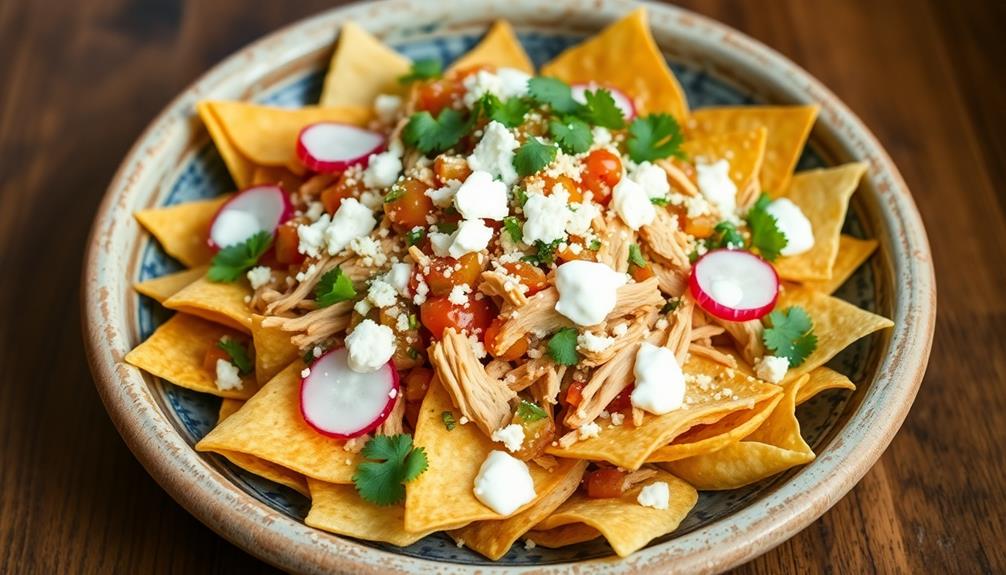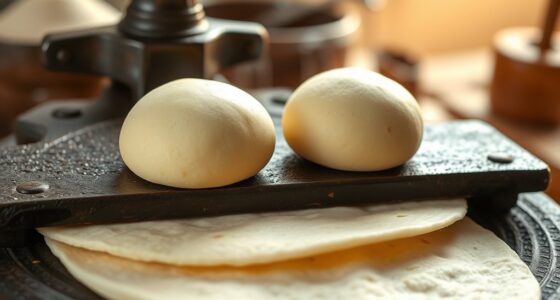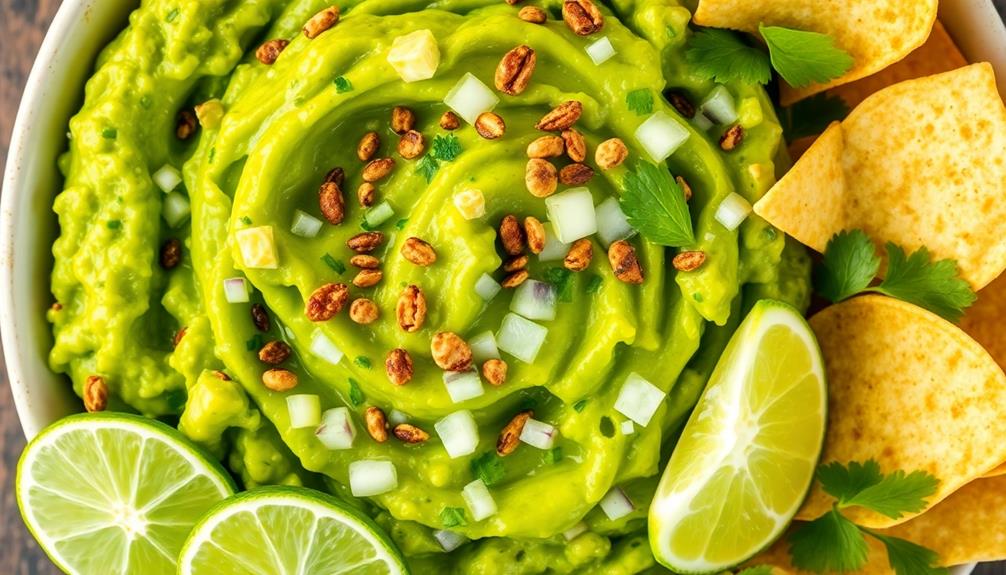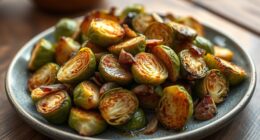Chilaquiles are the ultimate Mexican comfort food! These crispy tortilla chips are simmered in a tangy salsa, then loaded up with creamy toppings like cheese, sour cream, and avocado. The flavors are out of this world – spicy, savory, and delightfully satisfying. It's no wonder chilaquiles are a popular breakfast and brunch dish, bringing families and friends together to enjoy the rich culinary traditions of Mexico. If you're curious to learn more about the origins and regional variations of this beloved meal, keep reading to explore the vibrant history and culture behind the iconic chilaquiles.
Key Takeaways
- Chilaquiles is a traditional Mexican breakfast dish, originating from the Aztec civilization, that combines fried tortilla chips, salsa, and various toppings.
- The dish showcases regional variations in Mexico, incorporating ingredients like onions, cilantro, or refried beans, reflecting the diversity of Mexican culinary traditions.
- Chilaquiles is a versatile dish that can be enjoyed for breakfast, lunch, or dinner, and is often garnished with cheese, sour cream, and avocado.
- The key to making successful chilaquiles lies in balancing the flavors and textures of the fried tortilla chips, salsa, and toppings.
- Chilaquiles is considered a comfort food in Mexican households and is frequently featured in celebrations and festivals, representing the richness of Mexican cuisine.
History
Chilaquiles' origins can be traced back to the Aztec civilization, where they were a traditional breakfast dish made from leftover tortillas.
These crispy tortilla chips were simmered in a zesty red or green salsa, then topped with crumbled cheese, shredded chicken, and a fresh fried egg. Yum!
Over time, this humble dish evolved, with different regions of Mexico putting their own unique spin on the recipe. Some versions include diced onions, cilantro, or even refried beans.
The name "chilaquiles" comes from the Nahuatl language, combining the words "chil" meaning chili pepper and "atl" meaning water.
Today, chilaquiles are a beloved breakfast staple across Mexico, each family having their own special way of making this delicious and comforting dish.
Whether you enjoy them for breakfast, lunch, or even dinner, chilaquiles are a true taste of Mexican culinary heritage. These delicious and versatile dishes are made with crispy tortilla chips simmered in a flavorful sauce, and often topped with eggs, cheese, and other ingredients. If you’re looking to experience the authentic flavors of Mexico at home, try searching for a tasty chilaquiles recipe online and give it a go. It’s sure to become a new favorite in your household!
Recipe
Chilaquiles is a classic Mexican dish that combines fried tortilla chips, salsa, and a variety of toppings. It's a versatile and comforting meal that can be enjoyed any time of day.
The key to delicious chilaquiles is the balance of flavors and textures. The crispy tortilla chips provide a satisfying crunch, while the salsa and other toppings add layers of spice, acidity, and creaminess.
Ingredients:
- 8 corn tortillas, cut into quarters
- 1/2 cup vegetable oil
- 1 cup salsa (red or green)
- 2 eggs, fried
- 1/2 cup crumbled queso fresco
- 2 tablespoons chopped onion
- 2 tablespoons chopped cilantro
Cooking Instructions:
In a large skillet, heat the vegetable oil over medium-high heat. Add the tortilla quarters and fry until crispy and golden brown, about 2-3 minutes per batch. Drain the fried tortilla chips on a paper towel-lined plate.
In the same skillet, pour in the salsa and bring to a simmer. Add the fried tortilla chips and gently toss to coat them in the salsa. Cook for an additional 2-3 minutes, allowing the chips to absorb the flavors.
Serve the chilaquiles hot, topped with the fried eggs, crumbled queso fresco, chopped onion, and cilantro. Chilaquiles are a classic Mexican breakfast dish made with fried tortilla strips simmered in green or red salsa until tender. They are often served with an array of delicious toppings, making them a versatile and satisfying meal any time of day. This traditional Oaxacan dish is a perfect way to start your day with a burst of flavor and a hint of spice.
Extra Tips:
- For a heartier meal, you can add cooked shredded chicken or beef to the chilaquiles.
- Experiment with different types of salsa, such as tomatillo or mango salsa, to create unique flavor profiles.
- Garnish with avocado slices, sour cream, or crumbled cotija cheese for additional creaminess and richness.
Cooking Steps
First, you'll need to fry up some tortilla chips until they're nice and crispy.
Next, sauté some chopped onions and garlic in a pan.
Then, add in some tasty tomato sauce and shredded chicken.
Step 1. Fry Tortilla Chips Until Crispy

Next, you'll want to fry the tortilla chips until they're crispy.
Grab a large skillet and pour in enough oil to reach about a quarter-inch up the sides. Bring the oil to a nice, sizzling temperature over medium-high heat.
Carefully add a handful of tortilla chips to the hot oil, making sure not to overcrowd the pan. Fry the chips for about 2-3 minutes, flipping them occasionally, until they turn a beautiful golden-brown color and become delightfully crispy.
Use a slotted spoon to transfer the crispy chips to a paper towel-lined plate.
Repeat this process with the remaining tortilla chips, working in batches to avoid overcrowding.
Once all the chips are fried to perfection, you're ready to move on to the next step in creating your mouthwatering chilaquiles.
Get ready for some serious flavor!
Step 2. Sauté Chopped Onions and Garlic

With the crispy tortilla chips ready, it's time to sauté the aromatic onions and garlic.
In a large skillet, heat a splash of oil over medium heat. Toss in the diced onions and minced garlic, and let them sizzle until they become golden and fragrant, about 5 minutes. Stir them occasionally to prevent burning.
The juicy onions and pungent garlic will fill your kitchen with a mouthwatering aroma, making your taste buds tingle in anticipation.
As the onions and garlic cook, their flavors will meld and intensify, creating a flavorful base for your chilaquiles.
Be sure to keep a close eye on them, adjusting the heat as needed to achieve the perfect caramelized texture.
Once they're ready, it's time to add the next layer of flavor to your dish.
Step 3. Add Tomato Sauce
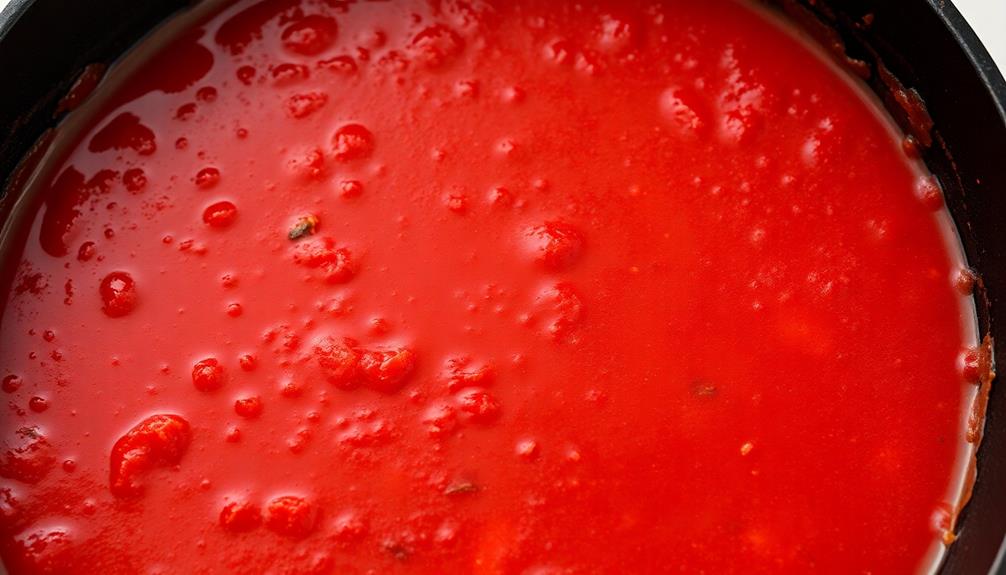
With the aromatic onions and garlic sizzling in the pan, it's time to add the next flavor component – the tomato sauce.
Grab that can of juicy, red tomato sauce and pour it right in. Listen as it sizzles and bubbles, releasing a heavenly aroma that will make your mouth water. Stir the sauce into the onions and garlic, making sure to coat every inch.
As the sauce heats up, you'll notice it thickening and becoming richer in color. This is exactly what you want – a nice, smooth and flavorful tomato sauce that will complement the crispy tortilla chips.
Now, give the mixture a good stir and let it simmer for a few minutes. This allows the flavors to meld together perfectly. You can even add a pinch of salt and pepper to taste, if you'd like.
The tomato sauce is the perfect foundation for your delicious chilaquiles. Get ready to layer on the other tasty toppings!
Step 4. Add Shredded Chicken
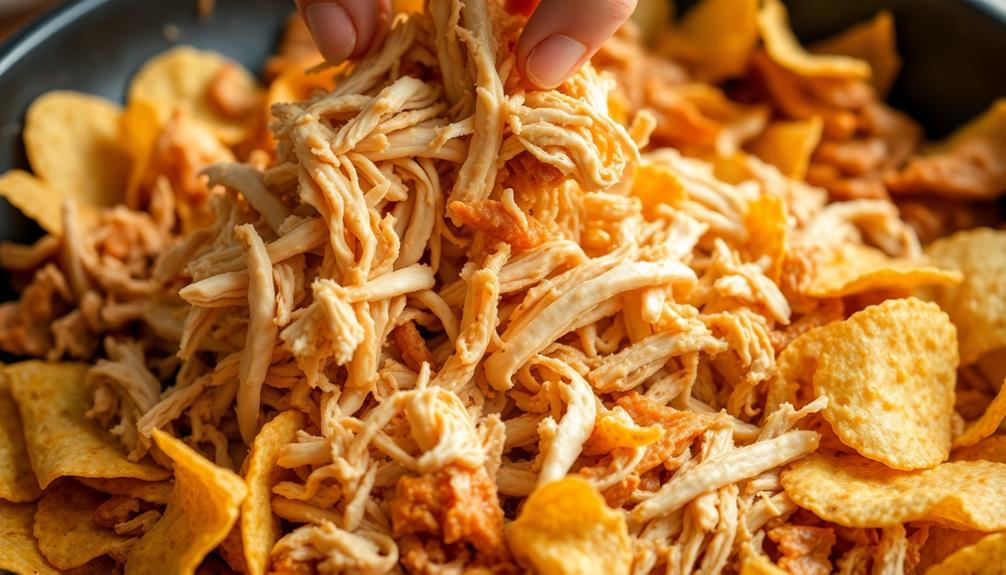
Now that the tomato sauce has simmered to perfection, it's time to add the shredded chicken. This is where the dish really comes together and takes on a delightful new flavor!
Grab a couple of forks and start shredding that juicy, tender chicken. As it mixes with the zesty sauce, the flavors will meld together beautifully. You can even shred the chicken right in the pan for ease.
Just make sure to give everything a good stir, so the chicken is evenly distributed. The aroma is simply mouthwatering – the savory chicken paired with the tangy tomato sauce is sure to have your taste buds dancing.
Now, scoop up those crispy tortilla chips and get ready to enjoy the perfect balance of textures and tastes. This is where the chilaquiles really start to shine.
Step 5. Combine All Ingredients and Simmer
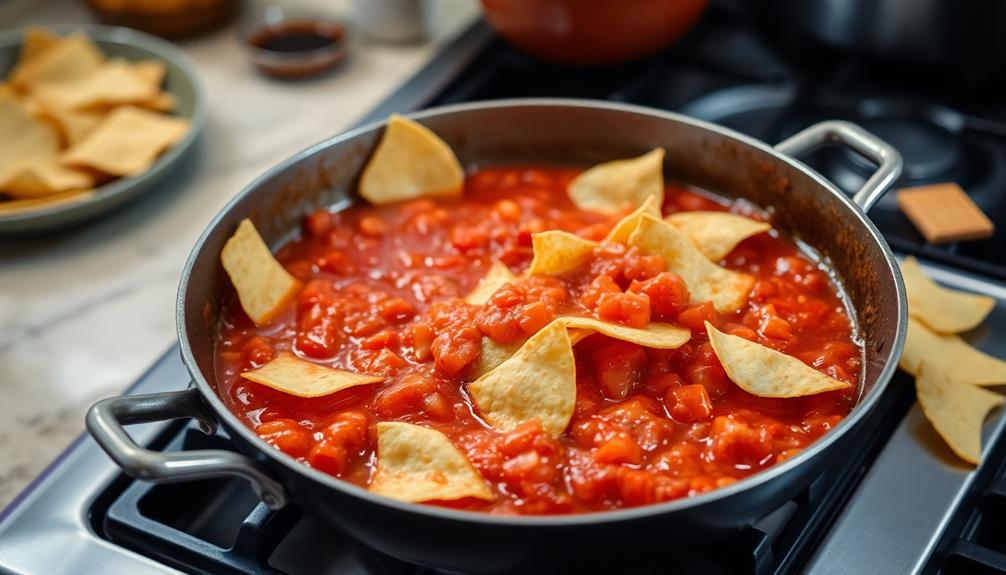
Next, add the shredded chicken to the simmering tomato sauce. Stir everything together until the chicken is heated through and coated in the delicious sauce. Mmm, doesn't that smell amazing?
Now, toss in the crispy tortilla chips and gently mix them in, making sure they get all saucy and flavorful. Yum! Let the whole dish simmer for a few more minutes, allowing the flavors to meld together perfectly.
As the chilaquiles bubble away on the stove, it's time to prepare the toppings. Crumble the tangy queso fresco over the top, then add a dollop of creamy sour cream. Don't forget the fresh cilantro – sprinkle it over everything for a bright, herby finish.
Now you're ready to serve up your delicious homemade chilaquiles! Grab a big spoon and dig in. Each bite is packed with savory goodness, crunch, and creaminess. Mmm, this is going to be one satisfying meal.
Final Thoughts
Chilaquiles are a beloved Mexican dish that have stood the test of time, offering a delightful balance of flavors and textures. Whether you prefer them crispy or soft, smothered in salsa or sprinkled with cheese, these versatile chilaquiles are a true delight.
The combination of fried tortilla chips, tangy salsa, and creamy toppings creates a symphony of tastes and textures that will have your taste buds dancing with joy. As you savor each bite, let the warmth of the dish envelop you, transporting you to the vibrant streets of Mexico.
The crunchy chips, the zesty salsa, and the comforting warmth of the dish come together to create a truly unforgettable culinary experience. Whether you're enjoying chilaquiles for breakfast, lunch, or dinner, they're sure to leave you feeling satisfied and eager to explore more of the rich and diverse flavors of Mexican cuisine.
Frequently Asked Questions
What Is the Difference Between Chilaquiles and Migas?
You may not know, but chilaquiles and migas are two distinct Mexican dishes. While chilaquiles feature fried tortilla chips in a sauce, migas are scrambled eggs with tortilla strips, peppers, and other savory ingredients.
Can I Use Store-Bought Tortilla Chips for Chilaquiles?
Sure, you can use store-bought tortilla chips for your chilaquiles. While homemade fried tortillas are traditional, store-bought chips work just fine and make the dish easier to prepare. The key is to ensure the chips are fresh and crispy.
How Do I Make Chilaquiles Vegetarian or Vegan?
To make your vegetarian or vegan dish, you can use store-bought tortilla chips as a base and top them with sautéed vegetables, plant-based protein, and a flavorful sauce. Customize it to suit your dietary preferences and taste buds.
Can I Prepare Chilaquiles Ahead of Time?
You can definitely prepare the dish ahead of time. Simply make the components separately and assemble right before serving. This allows you to enjoy the fresh flavors without the hassle of last-minute preparation.
What Are Some Topping Ideas for Chilaquiles?
When it comes to toppings, the possibilities are endless! You can get creative with things like shredded chicken, fried eggs, crumbled queso fresco, diced onions, chopped cilantro, and a drizzle of crema or salsa to really make your dish shine.
